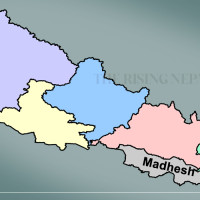- Sunday, 20 July 2025
Spring Skies, Lunar Adventures
Red Junglefowl (Gallus gallus) which is locally known in Nepal as "luiche" is a magnificent bird hailing from the Phasianidae family. It is the ancestor of modern-day domestic chickens, however, exhibiting noticeable differences. Often shy around humans compared to their domestic counterparts, these birds have been very significant to human societies for a long time, especially in the Gangetic region of India, where they were domesticated about 7,000 years ago.
The Red Junglefowl has been extensively recorded in Nepal since the 19th century, and it once used to live vastly in forests, fields, and on the outskirts of villages, although its numbers have witnessed a decline in recent times. These birds still live in forests under the protection of various national parks, community forests, and other such protected places in Nepal.
The genome sequencing of domestic chickens today has revealed that domestic chicken came into existence approximately 8,000 years ago and are now raised in most parts of the globe for meat, eggs, and companionship. The genetic composition of the domesticated birds falls between 71 and 79 per cent similar to the Red Junglefowl, but genetically remains distinct from other members of this bird genus within the range, such as Sri Lankan Junglefowl, Brown Junglefowl, and Green Junglefowl.
In Nepal, particularly in the Terai region, Chitwan National Park and its adjacent Kumroz and Kuchkuche community forests are the unique habitat of the Red Junglefowl. This forested area is an ideal place for birdwatchers to see and admire the birds.
Features
The Red Junglefowl is known for its extraordinary appearance, presenting a rich colour palette that shines wonderfully in the sun. Smaller in size as compared to domestic chickens, these birds have striking colours all over their bodies, especially males with brightly coloured decorative feathers. Males are larger than females, with long arching tail feathers that change colours under light to shades of blue, purple, white, and green.
Males of the bird can grow up to 28 inches, with tails up to 11 inches long and weighing around 1.5 kg. Females weigh around 1 kg. Their plumage contains a blend of black and reddish-orange feathers. Also, male eclipse plumage is noticeable during certain seasons.
Distinguishable by their voice, the roosters of Red Junglefowl produce lower sounds compared to the ones of domesticated roosters, and they use their voice for both mating and security calls. They mainly confront each other through the arches of their legs. They move in small groups consisting of a few males and a large number of females, with mixed-sex associates also being common. These creatures are active during the day, looking for fruits, seeds, insects, and various arthropods, before taking refuge in the trees at night. Although non-migratory, they tend to move much farther during drought periods when they try to find food for their survival.
Breeding
Red Junglefowls build their nests in shallow holes on the forest floor, usually camouflaged under the growths of bushes or plants made of grasses, leaves, sticks, and feathers. Males are adorned with brilliant feathers and perform impressive body motions, calling females by making clucking noises and head shaking. The female lays 3–7 eggs, which she then incubates for about 21 days. Breeding occurs in the fall or spring during dry periods. At 4-5 weeks old, hen chicks become independent, while at 12 weeks they leave their mothers’ group to initialise or join new ones. Females reach maturity at 5 months, while males do slightly later at this age.
Threats
The Red Junglefowl, despite being the most widely distributed species in its range, faces major challenges, mainly habitat loss, degradation, and uncontrolled hunting. Although it is secretive, the species faces these challenges, compounded by hybridisation with domestic chickens, which accounts for their dwindling populations. Though it is listed as least concerning by the IUCN Red List, the falling numbers emphasise the importance of conservation measures being taken.
According to ecologist Hem Bahadur Katuwal, Nepal has a fairly rich population of this species in the lowlands and Siwaliks, where it extends into areas that are under protection as well as those that are not. Forests, bushes, and farmlands are its main habitat. Its omnivore diet consists of seeds, grains, insects, fruits, and plant matter in general. The Red Junglefowl exhibits a social structure with a male-to-female ratio of approximately 1:3 and is found in hollow trees; their nests are made out of dry leaves, downy feathers, and twigs.
(The author is a wildlife photographer. The photos used in this article are by the author himself.)

















